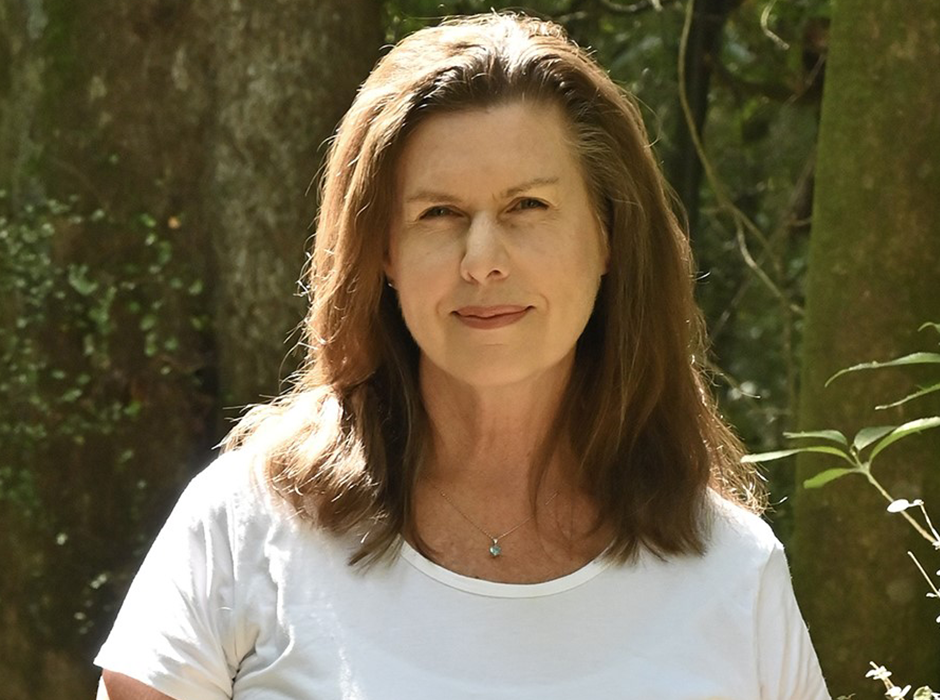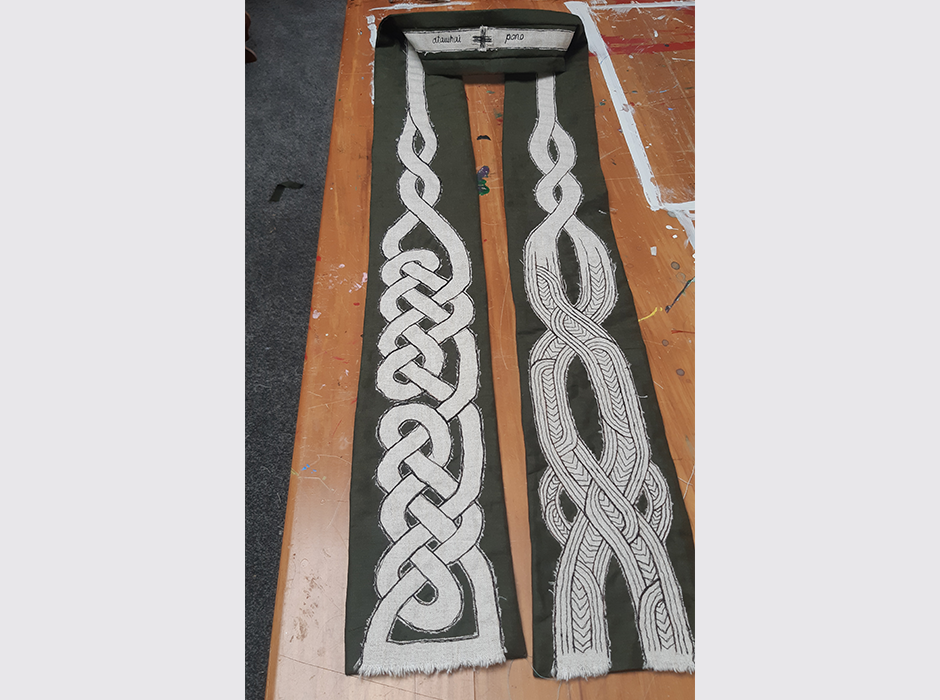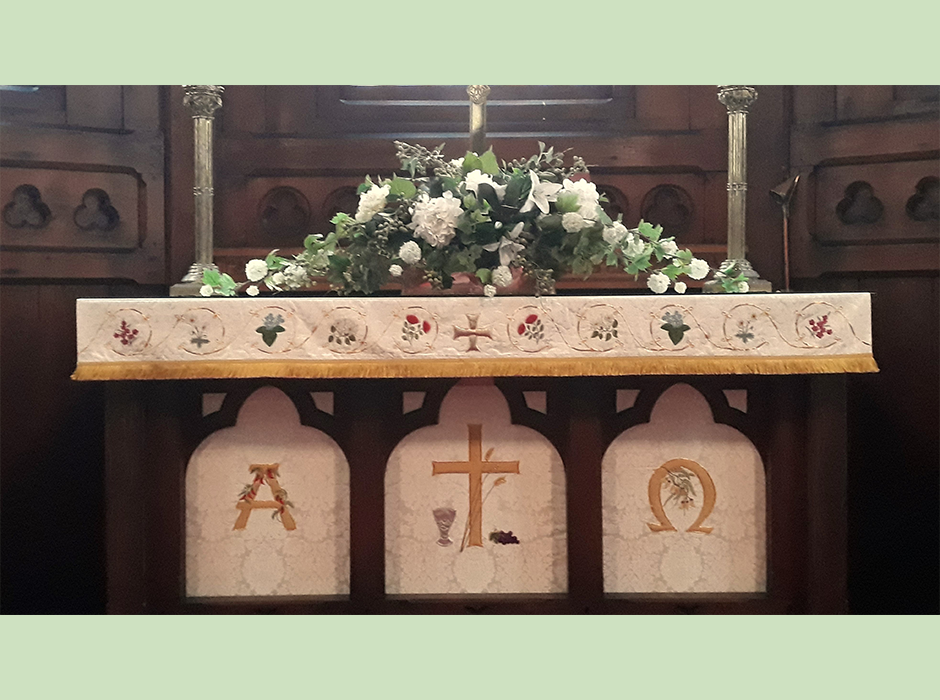
Donna Roy graduated with her Master's of Art in May. During her master's research, she spoke with many women about why they create ecclesiastical embroidery.
Women across the motu are creating community while simultaneously creating beautiful pieces of ecclesiastical embroidery for their church.
Donna Roy graduated from Otago with a Master’s of Art in May, and as part of her masters project, interviewed women from Anglican and Catholic faiths, to discover why they create pieces of embroidery for their church.
Donna has been a keen embroiderer, as was her mother, and is very interested in women’s expressions of faith.
“I grew up in the Anglican church, and my parents were very devoted to the church. My mother stitched a lot of white-on-white ecclesiastical embroidery.
“[My thesis] idea just arrived in a moment; to have a look at what women find meaningful in their stitching, what inspires them?”
Donna interviewed women aged between 38 and 92 and was surprised to find the main reason the women got involved in embroidery, working either individually or on a large group piece, was for the sense of community.
“It wasn’t at all what I was expected, [that] the predominant theme was community and connection, and women coming together in groups to stitch together.”
Donna spoke with an 80-year-old woman who had been a part of an embroidery group running for more than 50 years in Ōtautahi Christchurch. Not all the women who attend stitch anymore but they continue to meet with the group.
“So there’s that real bond that forms between women.”
Another woman, Hilda, ran a craft group at her local Catholic church for about 40 years and received a Queens Service Medal for her work.
Donna also interviewed two nuns.
“I was really fascinated by what beautiful souls they are, how filled with grace they were, and how joyful they were in their lives.”

Donna says this stole was stitched by Annette Cater, a priest in Lower Hutt. Annette made this for a priest with Scottish and Māori heritage - one side has a Celtic pattern and the other a traditional Māori pattern. At the intersection of the two designs there is a small cross for the priest to kiss as he completes his prayer prior to conducting a church service.
Embroidery, for them, was a form of prayer; “they found themselves in deeply meditative states”.
“When I started the project, I imagined that prayer and meditation might be the predominant theme, but it wasn’t.”
Some of the women Donna spoke with said it was important to them that they helped maintain a historical tradition. One worked at York Minster in England for 20 years as a part of the embroidery team.
“Her embroidery was of an extremely high standard, very technical. She was using a technique called nué requiring layering of gold threads.
“She was a real expert and her work, it was just phenomenal.”
Other women spoke about wanting to leave something behind of themselves that invited their descendants to share their faith.
“Although one woman said, ‘oh no, I don’t want to leave a legacy, I just want my work to have its day’.”
Many of the women interviewed were very creative, some generating their own patterns into their embroidery while incorporating religious symbols.
“One of the things that women do find meaningful is choosing the symbols. The process involves talking with the priest then creating a garment using appropriate symbols for them.
“I met with a group of women who are stitching a new altar cloth for Nelson Cathedral and were using local symbols of grapevines and wheat sheaves, symbols that are not only religious but very pertinent to the Nelson region.”
Another woman included a tiny bag of stones from the Wairarapa coastline on one of her pieces of embroidery. It was a nod to the local environment, but also held another meaning as Jesus is seen as The Rock, Donna says.
There are often multiple meanings to symbols – for example, ladybirds are sometimes used to represent Our Lady.

Donna says this altar frontal was stitched by the Wellington Cathedral Linen Guild members for Old St Paul’s in Wellington. She describes it as a “very beautiful altar frontal with traditional flowers”.
Donna saw many different styles of crosses during her research, some very traditional and others more modern, which again helped make the embroidered item more personal and meaningful.
Hard wearing textiles such as linen are predominantly used in churches but need to be properly cared for to ensure longevity. In church use, they are subjected to red wine stains and spilt wax Donna says.
Several different types of church linen can feature embroidery including altar cloths, purificators and pulpit drops, as well as stoles and copes for priests.
“A cope is a cloak that a priest would wear over their vestments. They’re often beautifully embroidered on the back and are normally made from really heavy-duty beautiful fabrics.”
Donna visited the Anglican Cathedral archives in the Wellington Cathedral and some of the piece she saw there were more than 100 years old. The embroiderers are mostly unknown but in recent years the Cathedral Guild has made an effort to record who worked on a garment or altar cloth.
“Textiles, unless stored properly, just disintegrate, except for in museums where they’re really cared for.
“There are examples of ecclesiastical embroidery in cathedrals overseas that are hundreds of years old, even dating back to the six hundreds. So this is a tradition that has been there for a long, long time.”
A highlight of Donna’s research was visiting the Auckland Anglican Cathedral archives. The archivist showed Donna a cope made for former St Paul’s Priest Bill Heald.
“They pulled out a cope that dated from the time I was a child of Saint Paul’s.”
The cope was designed by a well-known fashion designer at the time, Colin Cole for Father Bill.
“My parents were good friends with both of those people. So there was a little journey down into my own history, as well.”
-Kōrero by internal communications adviser, Koren Allpress